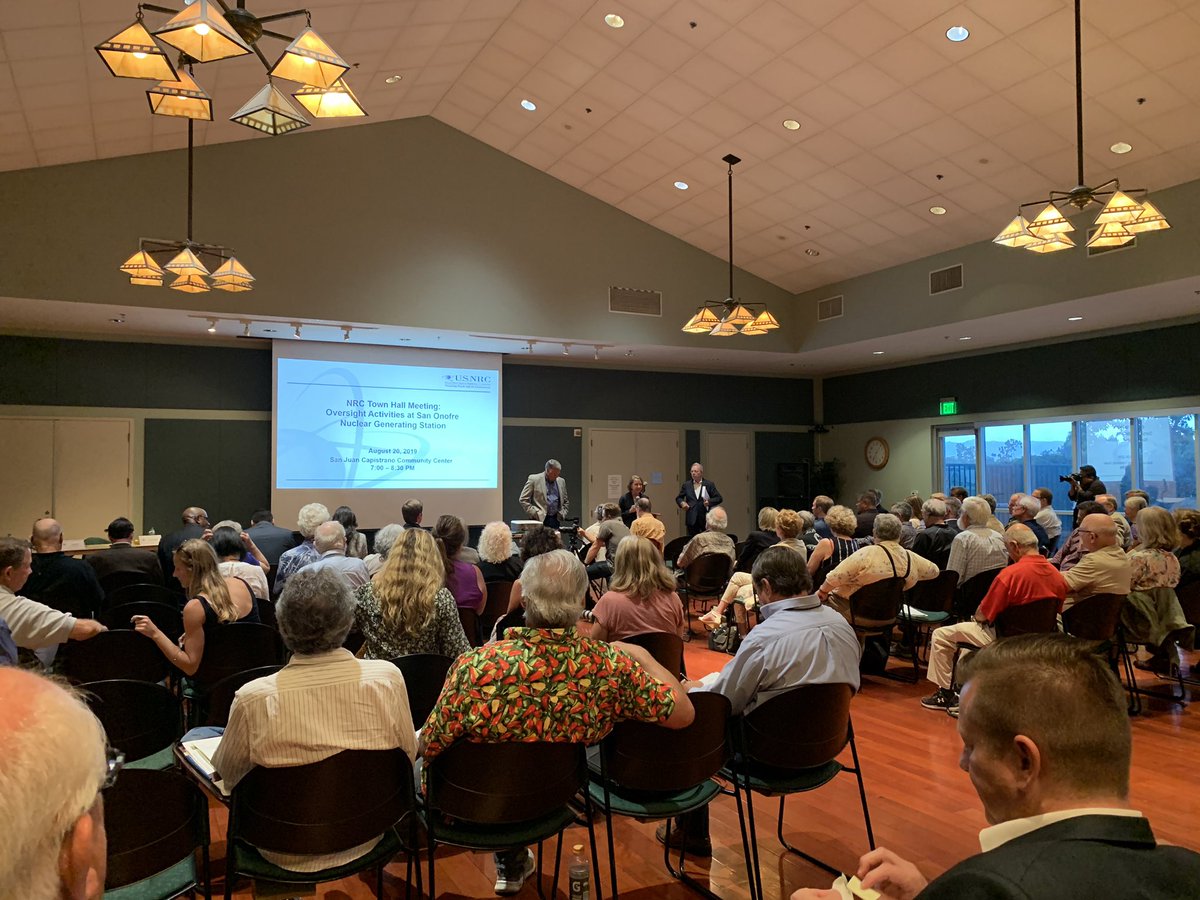We are here at the @NRCgov Town Hall in San Juan Capistrano.
#SanOnofreNuclear #SanOnofreandBeyond #SamuelLawrenceFoundation
#SanOnofreNuclear #SanOnofreandBeyond #SamuelLawrenceFoundation
@NRCgov Town Hall on San Onofre Nuclear. All rows are filled.
#SanOnofreandBeyond #SamuelLawrenceFoundation
#SanOnofreandBeyond #SamuelLawrenceFoundation

Greg Warnick, NRC Chief Reqxtor Inspector just shares that in late July inspectors found several issues.
Issue 1) during cleaning process on outside of transport cask a cleaning cloth was dropped into spend fuel pool.
Issue 1) during cleaning process on outside of transport cask a cleaning cloth was dropped into spend fuel pool.
2) failure to enter an issue about the staining of canister 31
3) @holtecintl worker walked under canister transporter heavy machinery. Required more than 4 hours of “safety time out”. The shield plate of transporter was closed for 4 hrs+ preventing air flow cooling.
At 4 hours workers partially opened shield plate.
Not proper procedure.
At 4 hours workers partially opened shield plate.
Not proper procedure.
4) monitors were not on during both insert and removal of canisters at interim spent fuel storage installation on-site.
The NRC also found water intrusion in the unloaded canisters stored on-site.
They closed the presentation by saying these issues do not have safety significance and that they were not “risk significant”.
#SanOnofreandBeyond #SamuelLawrenceFoundation
They closed the presentation by saying these issues do not have safety significance and that they were not “risk significant”.
#SanOnofreandBeyond #SamuelLawrenceFoundation
There are 49 speakers from the community. The community is concerned for their health and safety.
@RepMikeLevin is speaking now.
“SONGS’ record requires greater NRC inspection.”
“Restoring public trust requires that you [@NRCgov] take actions that are not merely ‘adequate’.”
@RepMikeLevin is speaking now.
“SONGS’ record requires greater NRC inspection.”
“Restoring public trust requires that you [@NRCgov] take actions that are not merely ‘adequate’.”
.@NRCgov just attempted to to do a 10-minute recess. To shouts and refusal of audience.
Portion of Scott Morris’ response, NRC Regional IV Administrator
#SanOnofreandBeyond
Portion of Scott Morris’ response, NRC Regional IV Administrator
#SanOnofreandBeyond
It’s a packed house at the NRC Town Hall on oversight at San Onofre.
#SanOnofreandBeyond #SamuelLawrenceFoundation #NuclearWaste #SanOnofreNuclear
#SanOnofreandBeyond #SamuelLawrenceFoundation #NuclearWaste #SanOnofreNuclear

Bobby Wallace Jr. is here of the Barona Band of Mission Indians #Kumeyaay
#SanOnofreandBeyond
#SanOnofreNuclear
#indigenouspeoples
#SanOnofreandBeyond
#SanOnofreNuclear
#indigenouspeoples
Lindsay spoke truth to power! 🔥
#SanOnofreandBeyond
#SamuelLawrenceFoundation
#SanOnofreNuclear
#NuclearWaste
#SanOnofreandBeyond
#SamuelLawrenceFoundation
#SanOnofreNuclear
#NuclearWaste
The people delivered the lemons 🍋 to the @NRCgov
#SanOnofreandBeyond
#SanOnofreNuclear
#SamuelLawrenceFoundation
#SanOnofreandBeyond
#SanOnofreNuclear
#SamuelLawrenceFoundation
• • •
Missing some Tweet in this thread? You can try to
force a refresh








